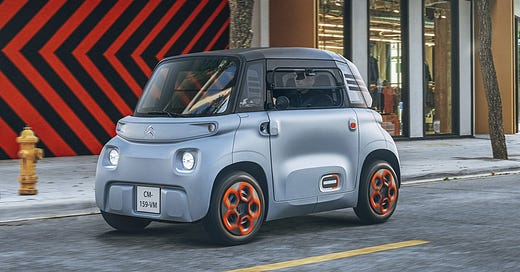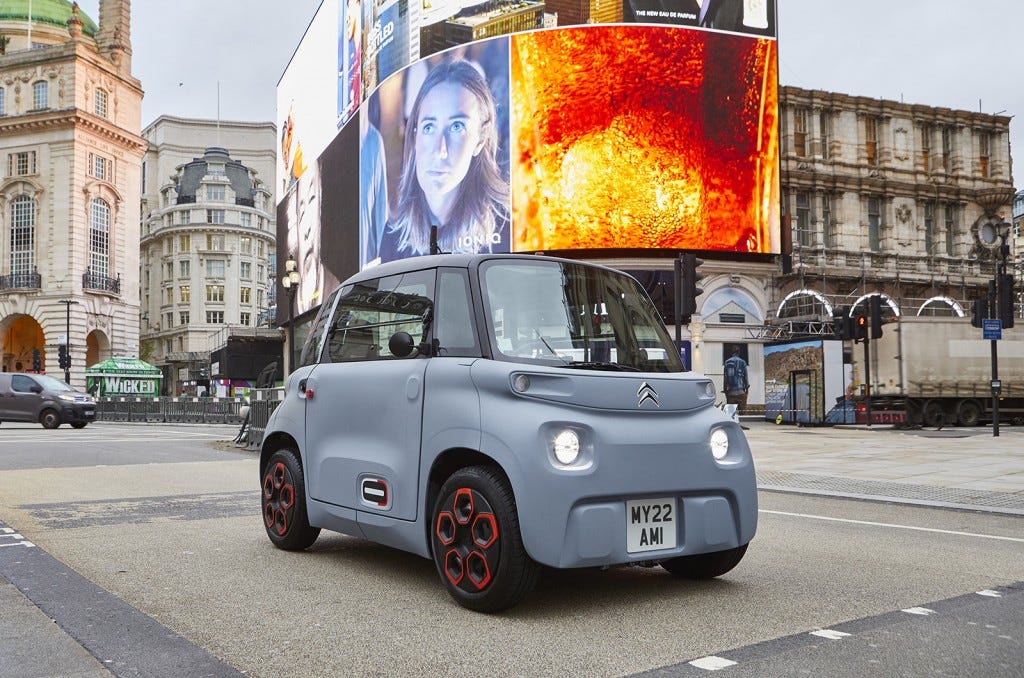Citroën Ami
Hello, electric car lovers! In this blog, I cover all the latest tech news surrounding electric cars. I cover the background, feel and drive, the current selling price, and the specs and engineering that go into making each car. If you have an electric car that you’d like me to cover let me know in the comments below. In today's article, I’m reviewing the new and upcoming The Citroën Ami. I’ll be covering the most important features to see whether it stands against the competition or not. Oh, and one more thing before I start - I accidentally hit an Eskimo with my electric car the other day. Luckily they were totally insulated.
Okkaayyyy... Now back to the article.
Background
The Citroen Ami is a two-passenger electric quadricycle built and marketed by the French automaker Citroen beginning in 2020. Altran has created a turnkey package for the vehicle.
It was shown as the Ami One concept vehicle in 2019. It takes its name from the original Citroen Ami, which was sold from 1961 until 1978.
The Citroen Ami was launched on February 27, 2020, at Paris La Défense Arena and became available in a special "Ami Blue" body color (blue-gray) that can be customized with stickers starting from June 2020. It is made in Morocco, at the PSA facility in Kenitra, to keep costs down.
Opel unveiled the Opel Rocks-e, a similar version of the car, in August 2021. It became available for purchase in November 2021.
Have you ever seen something like that before? The Citroen Ami is technically not a vehicle but rather a huge electric quadricycle.
In several European nations, the Ami can even be driven by 14-year-olds who do not have a driver's license. To drive one in the United Kingdom, for example, you must be 17 years old and properly licensed.
The Ami is unquestionably unique, and it's a unique way to move around in towns and cities where e-bikes and e-scooters for hire are becoming increasingly popular. It also creates a schism in public opinion. Its appearance alone, in my opinion, both charms and repels in equal measure.
However, there's no disputing its brilliance. Citroen has managed to cram in seats for two persons as well as a baggage room.
Despite its Dinky Toy charm and creative design touches, the Ami is not much smaller than other city vehicles, measuring 2.4m long and 1.4m wide. Consider the Smart ForTwo EQ, as well as four-seat competitors like the Fiat 500 and Volkswagen e-Up. In fact, a Renault Twizy is even smaller.
Unlike its competitors, the Ami's electric engine produces just 8 horsepower and has a peak speed of only 28 mph. Although Citroen claims that its compact battery can be charged to full in as little as three hours from a standard plug outlet, the official range is limited up to 46 miles between charges.
But, despite its eccentricities, how wonderful is the Citroen Ami? Over the next few minutes of this review, I'll show you how it stacks up against its main competitors in key aspects including performance, efficiency, comfort, and value for money.
Design and Engineering
Inspired by the AMI ONE concept presented in February 2019, the Citroën AMI is a real cube on wheels. Like I’ve mentioned before, 2.41 meters long, 1.36 m wide and 1.52 m high, it is camped on 14-inch wheels and plays on a symmetrical design.
This is particularly the case of the wide doors that are completely identical on the right and on the left, inducing a reversed opening direction: antagonist on the driver's side for better accessibility on board and classic on the passenger side. The front and rear fascias, lower bumpers and rocker panels are also repeated at the front and rear. Its composite material panels make the whole thing lighter. As a result, the Ami weighs 482 kg empty, or 562 kg while it’s running. Seven versions exist in the catalog, including the basic “Friend”. Four Gray, Blue, Orange and Khaki packs complete the offer, as well as two "Pop" and "Vibe" packs.
Interior
According to test drivers, the Citroen Ami has a high seating position, and the driver's seat may be moved forward and backward to accommodate drivers of varying heights and sizes.
There is only one driving option for the Ami: left-hand drive. Citroen claims that this enables kerbside access while parking in town centers, but for persons who are not accustomed to driving on the left-hand side of the car, this might be extremely unnerving. It also runs the danger of reducing visibility while changing lanes in a fast moving vehicle.
Because of the high driving position and the large quantity of glass that surrounds you, the Ami has excellent visibility, which helps to mitigate the problem. You're constantly acutely aware of the positions of the car's four corners. The only drawback is that the half-opening windows, which are split horizontally and can be flipped up, are inspired by the Citroen 2CV and may make you feel a little claustrophobic in tight quarters.
With the key-operated lock, which you twist and then shove hard, you get entry. It's amusing to note that the driver's door is rear-hinged, allowing for similar doors to be utilized on each side of the car, hence reducing expenses. Having said that, the Ami comes equipped with windows and doors as standard, in contrast to the Renault Twizy, which leaves you exposed to the elements.
Similarly to the outside, the interior's basic design is counterbalanced by the appeal of its layout, which appears to have been influenced at least in part by Duplo, the Lego pieces designed specifically for younger children. When it comes to the Ami, "minimalist" is definitely the operative word — aside from a small screen mounted behind the steering wheel and a cradle for your smartphone, there's very little in the way of extras to mention.
Considering its small size, the Citroen Ami is said to be surprisingly roomy. There's just enough for one passenger, similar to the Renault Twizy or Smart ForTwo EQ, except the seats are side by side instead of in the Twizy's jet fighter configuration. There's enough room promised in the seats for two adults to sit comfortably, and even tall people won't have trouble finding adequate headroom, reportedly.
The only storage space is a little cavern beneath the seats and the rather large area in front of the passenger's legs. It allows you to carry a surprising amount when combined with the car's height and a plethora of storage cubbies in the doors and in front of the dash.
Those who prefer baggage room or frequently carry more than one passenger, however, might choose the Ami's somewhat bigger four-seat competitors, such as the Fiat 500 or Volkswagen e-Up.
Performance
Every fair evaluation of the Citroen Ami must be weighed by its price and intended usage - which is a decent way of stating that any 'conventional' vehicle driver would discover that their driving experience is, in many respects, 'severely hampered' as described by reviews.
To begin with, the Ami's electric powertrain produces substantially less power than rivals such as the electric Fiat 500 and the Volkswagen e-Up (58 KW and 50 KW respectively). Despite this, the Ami's light weight and rapid power availability allow it to speed out of crossroads and through sluggish city traffic with said to be the same ease as any of its more powerful competitors.
However, for many, the 28mph speed limit will be a concern. Depending on where you're driving, this may or may not appear to be a constraint. It was found to be adequate in a busy metropolis, particularly in the numerous 20mph zones that have sprung up. For some car journalists who tested it, It was difficult not to feel like a nuisance in free-flowing traffic on a 30 mph route, and they said you'd feel genuinely exposed on a 40 mph stretch.
The ride is described as undoubtedly stiff, just like the Ami's closest competition, the little Renault Twizy, but it's not bad provided you remember to avoid huge potholes and pimples. It's not as comfy as its typical road-car rivals, but it's quite enough for short trips around town.
The driving is said to be direct enough to keep the Ami awake, and darting in and out of traffic is easy. Sharp maneuvers are also supposed to be a breeze, thanks to the 7.2m turning circle, which makes even the tightest conditions a breeze. Its length (or lack thereof) allows for parking in kerbs from the front or back. trainee driver were taken a out in the Ami, and they were enchanted by its simplicity.
Naturally, the electric motor allows you to begin your journey in near quiet, but it's reported that you could quickly discover that there is substantial road noise when driving (both from the tyres and the comments of other road users).
Battery Life
The usefulness of the Ami's stated 46-mile range is also constrained by the same factors. If you simply want to drive around a busy metropolis, the 5.5kWh battery will definitely be plenty for your everyday driving, especially since Citroen claims the battery can be charged from a standard socket in just three hours.
While official ranges should be regarded with caution, consumers looking to drive further afield could explore rivals such as the Fiat 500 (115 miles), Skoda Citigo e iV (170 miles), or e-Up (161 miles).
The Ami can only be charged with a three-pin household outlet, therefore you won't be able to utilize the same public charging network as other electric cars. The impact on your power bills will be significantly less than what you'd spend to fuel a petrol or diesel automobile, so running expenses should be cheap.
Price and Model range
Order intake began on May 11, 2020. The Citroën Ami is based on an original marketing method based on order intake accessible directly online. At the same time, the manufacturer has partnered with the FNAC-Darty duo to market the vehicle. Beginning in mid-June 2020, the brand can deliver directly to the customer's home for ($300), via “relay points” or in concessions.
In terms of price, Citroën especially highlights its long-term rental offer. Thus, with a 48-month commitment, the little electric chip on the rafters offers a monthly rent of $22.99. Please note, this requires a payment of a first rent of $3,644, bonus deducted. The firm also has terms of 24 and 36 months.
In full purchase, the manufacturer communicates a price of $7,900 excluding some government aid in Europe ($1000 for a quadricycle).
This wraps up my review of The Volkswagen e-UP, let me know what you think of it. Thank you for sticking it out through to the very end of this article! Nothing helps out my blog more than y’all reading the entire article. These articles take a long time to make and are a labor of love. If you would like to see my blog grow, please help spread the word and until next time, remember, the best experiences aren’t about where you end up, but who you’re lucky enough to be on the journey with.






